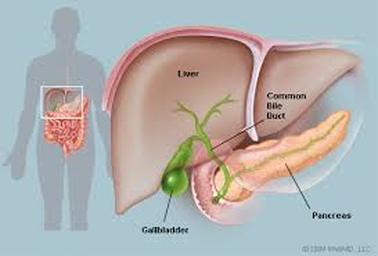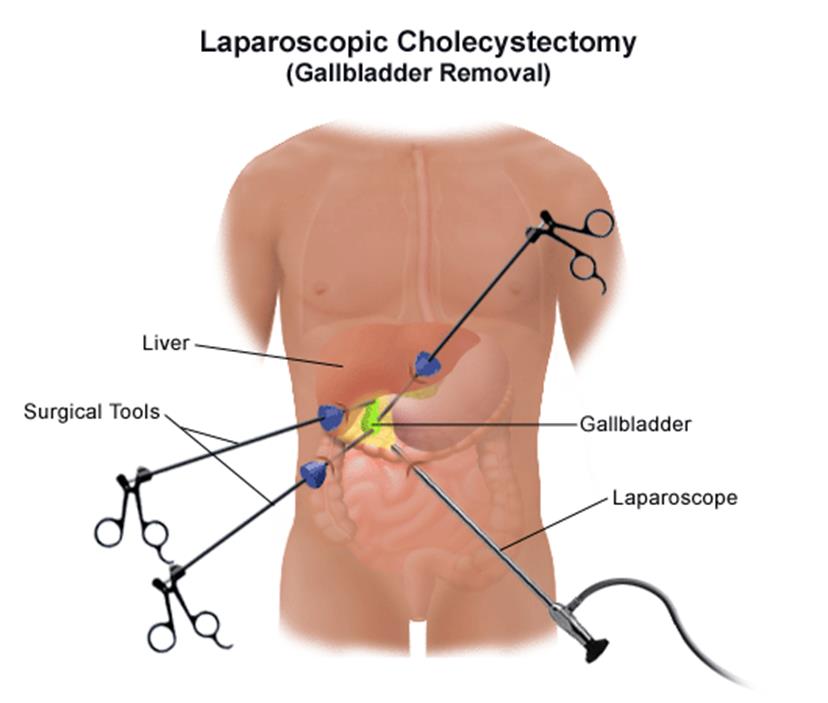
Gallstones
Gallstone is a prevalent disease in the world and has been even describe in ancient times as cause of digestive problems. In the develop and developing world, there is a about 25 percent prevalence of gallstones in the population. In the south east asia region, this is no different and recently we have seen an increment due to a change in the diet of the region following economic progress.Fortunately, a large majority are without symptoms (asymptomatic).
Below is a picture of the anatomy of the gallbladder in relation to the liver and liver ducts (call bile ducts):
There are basically three types of stone:
1. Cholesterol stones- these occur in patient who are usually overweight or those who eats a lot of high cholesterol and fried food. Patient on lipid lowering drugs are at risk of developing these types of stones. This is the most common type of stones in the develop or developing countries.
2. Pigmented stones- these are present in usually a younger age group and the risk factor is that they have some form of haemolytic anemia. Hemolytic anemia is a condition where the red blood cells have a lower life span and they are destroyed by the body at a faster rate than normal people. As result a lot of the by-products are excreted by the bile and these thickened bile forms stones in the gallbladder. Most of them have G6PD or mild minor thalassaemia carrier states which predisposes them to having stones.
3. Brown stones- these are common in under-develop countries and these stone can form in both the gallbladder, liver ducts and in the liver itself. The main cause is the possibility of liver infection call liver flukes which are found in untreated water.
As you can see from the above, the patients who have stones are those who usually slightly overweight and have poor dietary habits. However, once these stones are formed, changing the diet will not help in resolving the gallstones but these patient are encourage to keep a healthy diet to prevent heart attacks and strokes.
Symptoms of gallstones
Many of the symptoms are rather non-specific and not necessarily related to gallstones. They main symptoms of gallstone are listed below:
1. Upper abdominal bloatedness especially after fatty meal (biliary colic)
2. Epigastric pain which radiates to the back and or right shoulder
3. Nausea and vomiting during episode of pain
4. Fever may occur.
5. Severe epigastric/central abdominal pain.
These are early symptoms and if not treated it can lead to the following complications of gallbladder which are medical emergencies:
1. Acute cholecystitis (infection of the gallbladder)
2. Empyema of gallbladder (a bag of pus).
3. Pancreatitis (stone blocking the pancreas ducts)
4. Jaundice and cholangitis (stones blocking the liver ducts).
The above conditions need to be attended to immediately and be treated in a specialise hospital to prevent long term complications and even mortality.
These patients need to treated inpatient and will need intravenous antibiotics before having definitive treatment as discuss below
Investigations
Patient will usually present with non-specific upper abdominal pain. The two most important investigations required are:
1. Gastroscopy which is to exclude other cause of upper abdominal pain like peptic ulcer disease which can have similar symptoms with people with gallstones.
2. Ultrasound of the liver and gallbladder. This is the main stay of investigation to diagnose gallstones.
Treatment
Treatment is usually the need for complete removal of the gallbladder through minimally invasive surgery (laparoscopic cholecystectomy). Those patients who have infection will need some days on intravenous antibiotics before the surgical operation. Those patients who have jaundice and pancreatitis may need an endoscopic retrograde cholangio-pancreaticogram (ERCP) to clear the stones from the obstructed systems.
The use of medical treatment like dissolution treatment with medicine or “herbal extracts” have been shown not to be effective and may be dangerous.
The author would like to reiterate that patients with gallstones who have no symptoms at all, do not need any form of treatment. They can be left alone. If however, symptoms do develop then the patient would need treatment.
Laparoscopic cholecystectomy (see picture)
This is one of the most common minimally invasive surgery done in the world. It is a key hole surgery as shown in the diagram below. Through these small key hole the surgeon is able to remove the gallbladder. However, there is about a 3-5 percent chance that these may not be possible and the operation may have to be converted to an open classical operation.
The operation is very safe and has minimal risk. But the most important criteria in ensuring excellent results is finding the right surgeon who is trained in both hepatopancreatic biliary surgery and minimally invasive surgery. These is because one of the most worrying and dangerous complications of this surgery is bile duct injury. Although very rare (0.01%), it has dire consequences if not treated by specialised centres.
Patient usually need to stay in hospital for a day only and usually are back to work after three to four days. They are fit to perform heavy exercise within ten days of operation. The scars are minimal and within a couple of weeks will almost disappear.
Conclusion
Gallstones are common problem but fortunately very few of us suffer symptoms. If symptomatic, the treatment is usually surgical removal of the gallbladder and gallstones through minimally invasive surgery.
This operation is very safe but must be done by trained surgeons as the complications although rare can be quite disastrous.
Gallstone is a prevalent disease in the world and has been even describe in ancient times as cause of digestive problems. In the develop and developing world, there is a about 25 percent prevalence of gallstones in the population. In the south east asia region, this is no different and recently we have seen an increment due to a change in the diet of the region following economic progress.Fortunately, a large majority are without symptoms (asymptomatic).
Below is a picture of the anatomy of the gallbladder in relation to the liver and liver ducts (call bile ducts):
There are basically three types of stone:
1. Cholesterol stones- these occur in patient who are usually overweight or those who eats a lot of high cholesterol and fried food. Patient on lipid lowering drugs are at risk of developing these types of stones. This is the most common type of stones in the develop or developing countries.
2. Pigmented stones- these are present in usually a younger age group and the risk factor is that they have some form of haemolytic anemia. Hemolytic anemia is a condition where the red blood cells have a lower life span and they are destroyed by the body at a faster rate than normal people. As result a lot of the by-products are excreted by the bile and these thickened bile forms stones in the gallbladder. Most of them have G6PD or mild minor thalassaemia carrier states which predisposes them to having stones.
3. Brown stones- these are common in under-develop countries and these stone can form in both the gallbladder, liver ducts and in the liver itself. The main cause is the possibility of liver infection call liver flukes which are found in untreated water.
As you can see from the above, the patients who have stones are those who usually slightly overweight and have poor dietary habits. However, once these stones are formed, changing the diet will not help in resolving the gallstones but these patient are encourage to keep a healthy diet to prevent heart attacks and strokes.
Symptoms of gallstones
Many of the symptoms are rather non-specific and not necessarily related to gallstones. They main symptoms of gallstone are listed below:
1. Upper abdominal bloatedness especially after fatty meal (biliary colic)
2. Epigastric pain which radiates to the back and or right shoulder
3. Nausea and vomiting during episode of pain
4. Fever may occur.
5. Severe epigastric/central abdominal pain.
These are early symptoms and if not treated it can lead to the following complications of gallbladder which are medical emergencies:
1. Acute cholecystitis (infection of the gallbladder)
2. Empyema of gallbladder (a bag of pus).
3. Pancreatitis (stone blocking the pancreas ducts)
4. Jaundice and cholangitis (stones blocking the liver ducts).
The above conditions need to be attended to immediately and be treated in a specialise hospital to prevent long term complications and even mortality.
These patients need to treated inpatient and will need intravenous antibiotics before having definitive treatment as discuss below
Investigations
Patient will usually present with non-specific upper abdominal pain. The two most important investigations required are:
1. Gastroscopy which is to exclude other cause of upper abdominal pain like peptic ulcer disease which can have similar symptoms with people with gallstones.
2. Ultrasound of the liver and gallbladder. This is the main stay of investigation to diagnose gallstones.
Treatment
Treatment is usually the need for complete removal of the gallbladder through minimally invasive surgery (laparoscopic cholecystectomy). Those patients who have infection will need some days on intravenous antibiotics before the surgical operation. Those patients who have jaundice and pancreatitis may need an endoscopic retrograde cholangio-pancreaticogram (ERCP) to clear the stones from the obstructed systems.
The use of medical treatment like dissolution treatment with medicine or “herbal extracts” have been shown not to be effective and may be dangerous.
The author would like to reiterate that patients with gallstones who have no symptoms at all, do not need any form of treatment. They can be left alone. If however, symptoms do develop then the patient would need treatment.
Laparoscopic cholecystectomy (see picture)
This is one of the most common minimally invasive surgery done in the world. It is a key hole surgery as shown in the diagram below. Through these small key hole the surgeon is able to remove the gallbladder. However, there is about a 3-5 percent chance that these may not be possible and the operation may have to be converted to an open classical operation.
The operation is very safe and has minimal risk. But the most important criteria in ensuring excellent results is finding the right surgeon who is trained in both hepatopancreatic biliary surgery and minimally invasive surgery. These is because one of the most worrying and dangerous complications of this surgery is bile duct injury. Although very rare (0.01%), it has dire consequences if not treated by specialised centres.
Patient usually need to stay in hospital for a day only and usually are back to work after three to four days. They are fit to perform heavy exercise within ten days of operation. The scars are minimal and within a couple of weeks will almost disappear.
Conclusion
Gallstones are common problem but fortunately very few of us suffer symptoms. If symptomatic, the treatment is usually surgical removal of the gallbladder and gallstones through minimally invasive surgery.
This operation is very safe but must be done by trained surgeons as the complications although rare can be quite disastrous.
